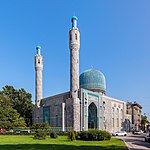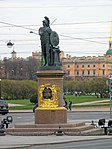Old Trinity Cathedral

The Old Trinity Cathedral (also known as Peter's Trinity Cathedral, Троице-Петровский собор) was the oldest church in St. Petersburg, Russia. It was there that Peter the Great celebrated the end of the Great Northern War in 1721 and was proclaimed the first Emperor of All Russia. It was one of the city's most cherished monuments until the Soviets ordered its destruction in 1933. The site on the Neva River bank is commemorated by a chapel. The diminutive church was built in 1743–46 as a copy of the simple wooden building commissioned by Peter the Great in 1709, with a bell/clocktower dating from 1713. Despite its small size, the Russian Orthodox Church considered it the main cathedral in the city, second only to St. Isaac's. In 1913, after a fire gutted the dilapidated structure, plans for a larger church building on the site were blocked by a group of history enthusiasts.
Excerpt from the Wikipedia article Old Trinity Cathedral (License: CC BY-SA 3.0, Authors, Images).Old Trinity Cathedral
Троицкая площадь П.С., Saint Petersburg Petrograd Side (Посадский округ)
Geographical coordinates (GPS) Address Nearby Places Show on map
Geographical coordinates (GPS)
| Latitude | Longitude |
|---|---|
| N 59.9517 ° | E 30.3257 ° |
Address
Часовня во имя Святой Троицы
Троицкая площадь П.С. 2
197046 Saint Petersburg, Petrograd Side (Посадский округ)
Saint Petersburg, Russia
Open on Google Maps











